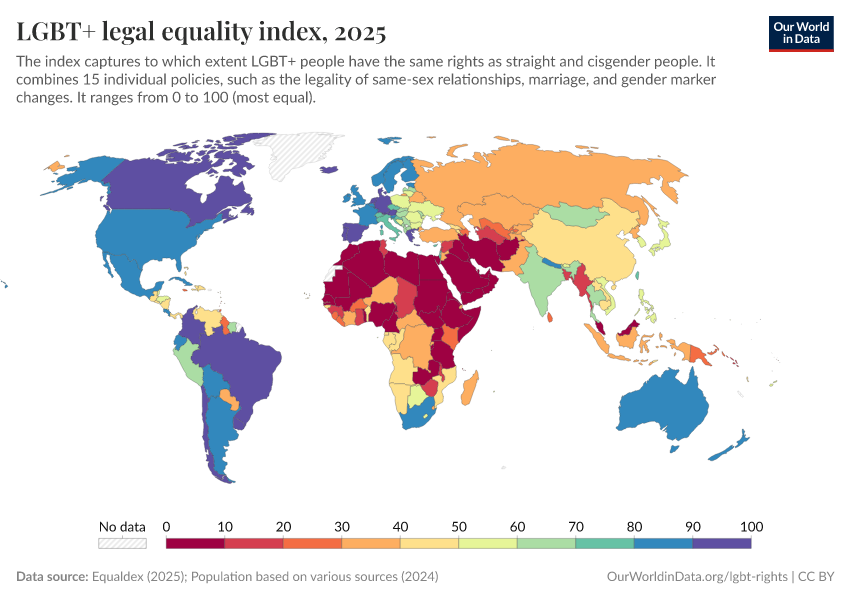Legal equality index

What you should know about this indicator
- The index combines 15 individual policies: the legality of same-sex relationships, marriage, gender marker changes, censorship of LGBT+ issues, gender-affirming care, legal recognition of non-binary gender, LGBT+ discrimination, employment discrimination, housing discrimination, same-sex adoption, serving openly in the military, blood donations by men who have sex with men, conversion therapies, and equal age of consent between same-sex and different-sex partners.
- Each of these policies is weighted differently, with the most important policies receiving the highest weights. These weights are called total possible scores.
- Each policy status has a factor associated to it, ranging from 0 to 1. Higher scores indicate more equality.
- The index is calculated by summing the product of total possible scores and the factor for each policy, divided by the sum of total possible scores.
- For more information about the methodology and the specific scores used, please refers to the Equaldex Equality index methodology.
What you should know about this indicator
- The index combines 15 individual policies: the legality of same-sex relationships, marriage, gender marker changes, censorship of LGBT+ issues, gender-affirming care, legal recognition of non-binary gender, LGBT+ discrimination, employment discrimination, housing discrimination, same-sex adoption, serving openly in the military, blood donations by men who have sex with men, conversion therapies, and equal age of consent between same-sex and different-sex partners.
- Each of these policies is weighted differently, with the most important policies receiving the highest weights. These weights are called total possible scores.
- Each policy status has a factor associated to it, ranging from 0 to 1. Higher scores indicate more equality.
- The index is calculated by summing the product of total possible scores and the factor for each policy, divided by the sum of total possible scores.
- For more information about the methodology and the specific scores used, please refers to the Equaldex Equality index methodology.
Sources and processing
This data is based on the following sources
How we process data at Our World in Data
All data and visualizations on Our World in Data rely on data sourced from one or several original data providers. Preparing this original data involves several processing steps. Depending on the data, this can include standardizing country names and world region definitions, converting units, calculating derived indicators such as per capita measures, as well as adding or adapting metadata such as the name or the description given to an indicator.
At the link below you can find a detailed description of the structure of our data pipeline, including links to all the code used to prepare data across Our World in Data.
Notes on our processing step for this indicator
- We have extracted the data from the official Equaldex JSON API.
- We combine the historical and current data extracted from the API to create a time series.
- Whenever policy implementation dates for a status are not provided in the data, and this status is the only available for the country, we consider that this status has not changed during the entire period of the dataset.
- We group some of the categories the source has defined for each issue, for further clarity in our visualizations.
- We present this data only for sovereign states, defined by Butcher and Griffiths (2020). We use the definitions of the latest year available.
Reuse this work
- All data produced by third-party providers and made available by Our World in Data are subject to the license terms from the original providers. Our work would not be possible without the data providers we rely on, so we ask you to always cite them appropriately (see below). This is crucial to allow data providers to continue doing their work, enhancing, maintaining and updating valuable data.
- All data, visualizations, and code produced by Our World in Data are completely open access under the Creative Commons BY license. You have the permission to use, distribute, and reproduce these in any medium, provided the source and authors are credited.
Citations
How to cite this page
To cite this page overall, including any descriptions, FAQs or explanations of the data authored by Our World in Data, please use the following citation:
“Data Page: Legal equality index”, part of the following publication: Bastian Herre and Pablo Arriagada (2023) - “LGBT+ Rights”. Data adapted from Equaldex, Various sources. Retrieved from https://archive.ourworldindata.org/20251023-195030/grapher/lgbt-legal-equality-index.html [online resource] (archived on October 23, 2025).How to cite this data
In-line citationIf you have limited space (e.g. in data visualizations), you can use this abbreviated in-line citation:
Equaldex (2025); Population based on various sources (2024) – with major processing by Our World in DataFull citation
Equaldex (2025); Population based on various sources (2024) – with major processing by Our World in Data. “Legal equality index” [dataset]. Equaldex, “Equaldex”; Various sources, “Population” [original data]. Retrieved November 4, 2025 from https://archive.ourworldindata.org/20251023-195030/grapher/lgbt-legal-equality-index.html (archived on October 23, 2025).